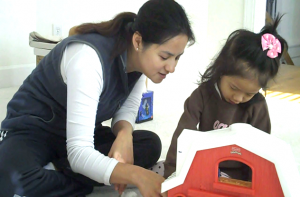Individual Growth and Development Indicators (IGDIs) for Infants and Toddlers are tools that provide helpful information about children’s growth toward socially valued outcomes that can guide intervention decisions. IGDIs are performance measures especially designed for use by childcare practitioners to reflect individual children’s progress toward general outcomes:
IGDIs are performance measures especially designed for use by childcare practitioners to reflect individual children’s progress toward general outcomes:
Communication: The child uses gestures, sounds, words, or sentences to convey wants and needs or to express meaning to others.
Movement/Motor: The child moves in a fluent and coordinated manner to play and participate in home, school, and community settings.
Social: Child interacts with peers and adults, maintaining social interactions and participating socially, in home, school, and community settings.
Problem Solving: Child solves problems that require reasoning about objects, concepts, situations, and people.
IGDIs, like pediatricians’ height and weight charts, display an individual growth trend over time, compared to normative growth. They show this trend in an indicator that is measured frequently over time (i.e., monthly, quarterly). It is well known that height and weight are sensitive indicators of the general health status of an infant or toddler. The lack of an expected growth rate here evokes a pediatrician’s concern and prompts reflection on the problem, its causes, and its possible solutions.
Lack of progress on an IGDI often indicates the need for a more in-depth assessment: to identify what the child can and cannot do, plan for an intervention, or change an existing intervention. Similar to height and weight charts that are used to monitor an infant’s general health status, IGDIs are used to measure progress (growth and development) within early communication, movement, social skills, and problem solving.
Common Characteristics of IGDIs
- Identify “authentic” child behaviors in natural settings.
- Are standardized and replicable so that the data from separate administrations are comparable.
- Meet the requirement for criterion validity in that they measure the general outcome that they are intended to measure.
- Meet the requirements for reliability, including inter-observer agreement, internal consistency, and reliability of alternate forms, so as to provide accurate information for use in intervention decision making.
- Are sensitive to growth over a short period of time so they can be used to evaluate intervention effectiveness.
- Are sensitive to intervention effects.
- Are efficient and economical, allowing practitioners to gather data that are usable for decision-making without unduly adding to their workload.
- Are tools that improve the communication and collaboration between parents and those professionals serving their children.
Differences Between IGDIs and other Traditional Forms of Measurement
- They may be repeated as often as weekly, unlike most standardized measures that require 6 months or more before they may be repeated.
- They take less time to administer: for example, 6 to 10 minutes, versus 20 to 60 minutes.
- They are designed for use by practitioners in home and childcare settings, unlike other assessments that are designed for specialists (like occupational and physical therapists) and so require clinical or specialized settings for administration.
- They are directly relevant to decision-making about interventions, whereas others are not.
- They directly reflect growth over time: a concept that is important to practitioners, parents, and others working with young children.
- They are comparatively more affordable to learn and to use when compared to many traditional forms of measurement.
Return to the top of this page.
